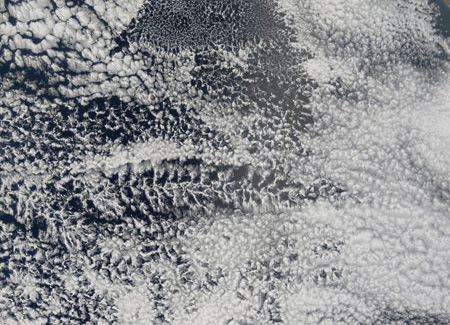A .gov website belongs to an official government organization in the United States.
A lock () or https:// means you've safely connected to the .gov website. Share sensitive information only on official, secure websites.
11 September 2017
adapted from the story by CIRES Communications

NOAA-led team uses an innovative network approach to explain polygonal patterns in clouds.
Polygons are widespread in nature: Drying mud may crack into many-sided blocks, and bees shape honeycomb into regular, six-sided cells. Hexagons also appear in broad sheets of clouds across parts of Earth's oceans, and now a team of researchers has used a network approach to analyze why. Their work promises to help scientists represent clouds more accurately in computer models of weather and climate change.
Large decks of stratocumulus clouds self-organize into honeycomb-like patterns. "These types of clouds cool the planet by reflecting solar radiation but their description in climate models is still rather crude," said lead author Franziska Glassmeier. She found that she could use a relatively simple mathematical model to re-create the cloud patterns, which are shaped in nature by a complex interplay of physical processes.
The new paper, co-authored by NOAA ESRL CSD scientist and CIRES Fellow Graham Feingold, is published in this week's edition of the journal Proceedings of the National Academy of Sciences. The work was supported in part by the CIRES Innovative Research Program (2015 awarded grant: Network Theory to Understand Cloud Systems).
Since the first satellite images in the early 60s, scientists have recognized that stratocumulus clouds – carpet-like, low clouds often draped across large sections of subtropical oceans – look like imperfect honeycombs. Sometimes the cells are "closed," with cloudy areas in the cells surrounded by cloud-free rings; and sometimes they are "open," with cloud-free cells surrounded by cloudy rings. The pattern constantly changes as cells emerge, disappear, and re-arrange.
The researchers ran highly detailed simulations of clouds to capture the precise air movements that create these patterns: in general, where air moves up it creates cloudy regions, and where it descends, cloud-free regions form. They then applied a mathematical technique called Voronoi tessellation to translate air movements into a network of polygonal tiles. The simple mathematical model developed by Glassmeier and Feingold re-creates this pattern. "It is like creating a dynamic mosaic with specific rules that allow one to replace different patches with a new set of tiles over and over again," Glassmeier explains. Their model offers a fundamental explanation for the structure and dynamics of stunning stratocumulus cloud decks.
And perhaps more importantly, the network analysis technique can help to produce more accurate clouds in computer models. "Clouds still represent a significant uncertainty in our climate projections," said Feingold. "Our hope is that this novel cellular network approach will lead to new ways of looking at the cloud parameterization problem."
Franziska Glassmeier and Graham Feingold, A network approach to patterns in stratocumulus clouds, Proceedings of the National Academy of Sciences, doi:10.1073/pnas.1706495114, 2017.
The representation of stratocumulus (Sc) clouds and the description of their radiative impact based on large-scale mean quantities is one of the largest challenges for global climate models. Sc fields self-organize into cellular patterns and thus lend themselves to analysis and quantification in terms of cellular networks. Using Sc fields based on large-eddy simulations, we describe these cellular networks and present a first analysis of their structure and self-organization. Our network analysis shows that the Sc pattern is scale-invariant as a consequence of entropy maximization known as Lewis's Law (scaling parameter: 0.16), and largely independent of the Sc regime (cloud-free vs. cloudy cell centers). Cells are on average hexagonal with a neighbor number variance of about 2 and larger cells tend to be surrounded by smaller cells, as described by an Aboave-Weaire parameter of 0.9. The network structure is neither completely random nor characteristic to natural convection. Instead it emerges from Sc-specific versions of cell division and cell merging that are shaped by cell expansion. This is shown with a heuristic model of network dynamics that incorporates our physical understanding of cloud processes.